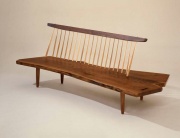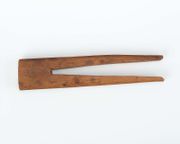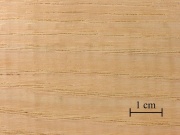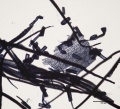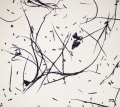Difference between revisions of "Hickory"
(username removed) |
|||
| (11 intermediate revisions by 5 users not shown) | |||
| Line 1: | Line 1: | ||
| − | [[File:1979.275-C33988CR-d1.jpg|thumb|]] | + | [[File:1979.275-C33988CR-d1.jpg|thumb|Walnut and hickory bench<br>MFA# 1979.275]] |
| + | [[File:Clothes pin MFA.jpg|thumb|Shaker clothes pin<br>MFA# 67.67c]] | ||
== Description == | == Description == | ||
| − | Any of several North American trees of the genus Carya, such as the white hickory tree (Hicoria alba). Hickory trees are found from New Hampshire to Texas. Hickory timber is valued because it is strong, elastic and shock resistant. The reddish brown wood has a straight grain and a fine texture that polishes well. Pecan is one well-known type of hickory. Hickory is used for flooring, tool handles, farm implements, chairs, wheel spokes, golf clubs, and baseball bats. It is also split into thin canes for weaving. | + | Any of several North American trees of the genus Carya, such as the white hickory tree (''Hicoria alba''). Hickory trees are found from New Hampshire to Texas. Hickory timber is valued because it is strong, elastic and shock resistant. The reddish brown wood has a straight grain and a fine texture that polishes well. [[Pecan]] is one well-known type of hickory. Hickory is used for flooring, tool handles, farm implements, chairs, wheel spokes, golf clubs, and baseball bats. It is also split into thin canes for weaving. |
| − | See also [ | + | See also [[hickory bark]] |
| − | [[File:36_Hickory.jpg|thumb|Hickory | + | [[File:36_Hickory.jpg|thumb|Hickory (''Hicoria ovata'')]] |
| − | |||
== Synonyms and Related Terms == | == Synonyms and Related Terms == | ||
| − | white hickory trees (''Hicoria alba, Carya alba, | + | white hickory trees (''Hicoria alba, Carya alba, or Carya tomentosa''); shagbark hickory (''Carya ovata''); pecan (''Hicoria pecan or Carya illinoinensis''); Almindelig Hassel (Dan.); Gemeine Hasel (Deut.); Haselstrauch (Deut.); Haselnußstrauch (Deut.); pecan (Esp.); noisetier (Fr.); coudrier (Fr.); Nocciolo (It.); Avellana (It.); hazelaar (Ned.); Hassel (Nor.); Leszczyna pospolita (Pol.); cária (Port.); hasseln (Sven.) |
| − | == | + | == Physical and Chemical Properties == |
| − | Medium tree | + | Medium tree growing to 30 m with straight trunk and rounded crown. Bark=gray with shallow ridges and furrows. Leaves=oval (20-30cm) with serrated edges Fruit=obovoid (3-5 cm) with thick husk containing edible ribbed nut. Density = 37-58 ppcf |
| − | + | Paper fiber type: hardwood, ring porous. Using transmitted light microscopy, pulp is identified by vessels of two sizes with an irregular arrangement of small pits that may appear variegated. Large barrel-shaped early wood vessels may be fragmented. Perforations are simple. Tyloses are present. Average dimensions of fibers: length 1.3mm, 17μm wide. Appearance with [[Graff "C" stain]]: dark blue, but varies with bleaching. Common pulping method: [[kraft process|kraft]]. | |
| − | |||
| − | |||
| − | |||
| − | |||
== Additional Images == | == Additional Images == | ||
| Line 30: | Line 26: | ||
File:38_Pignut Hickory_100x_Tran.jpg|Pig-nut Hickory (''Hicoria ovata'') | File:38_Pignut Hickory_100x_Tran.jpg|Pig-nut Hickory (''Hicoria ovata'') | ||
File:Hickoryf5.jpg|Shagbark hickory ''Carya ovata'' | File:Hickoryf5.jpg|Shagbark hickory ''Carya ovata'' | ||
| + | File:Hickory 40x earlywood.jpg|Hickory paper pulp stained with Graff "C"stain | ||
| + | File:Hickory 10x.jpg|Hickory paper pulp stained with Graff "C"stain | ||
</gallery> | </gallery> | ||
| + | == Resources and Citations == | ||
| − | + | * F. H. Titmuss, ''Commercial Timbers of the World'', The Technical Press Ltd., London, 1965 Comment: 45-55 ppcf | |
| − | * | + | * Edward Reich, Carlton J. Siegler, ''Consumer Goods: How to Know and Use Them'', American Book Company, New York City, 1937 |
| − | * | + | * Virginia Tech Dendrology website at www.fw.vt.edu/dendro/dendrology/main.htm (accessed Oct. 8, 2005) |
| − | * | + | * Wikipedia: http://en.wikipedia.org/wiki/Hickory (Accessed Oct. 8, 2005) |
| − | * | + | * G.S.Brady, ''Materials Handbook'', McGraw-Hill Book Co., New York, 1971 Comment: p. 396 |
| − | |||
| − | |||
* ''Van Nostrand's Scientific Encyclopedia'', Douglas M. Considine (ed.), Van Nostrand Reinhold, New York, 1976 | * ''Van Nostrand's Scientific Encyclopedia'', Douglas M. Considine (ed.), Van Nostrand Reinhold, New York, 1976 | ||
| − | * | + | * Random House, ''Webster's Encyclopedic Unabridged Dictionary of the English Language'', Grammercy Book, New York, 1997 |
* ''The American Heritage Dictionary'' or ''Encarta'', via Microsoft Bookshelf 98, Microsoft Corp., 1998 | * ''The American Heritage Dictionary'' or ''Encarta'', via Microsoft Bookshelf 98, Microsoft Corp., 1998 | ||
| Line 53: | Line 50: | ||
* ''CRC Handbook of Chemistry and Physics'', Robert Weast (ed.), CRC Press, Boca Raton, Florida, v. 61, 1980 Comment: density=37-58 ppcf (0.60-0.93 g/cm3) | * ''CRC Handbook of Chemistry and Physics'', Robert Weast (ed.), CRC Press, Boca Raton, Florida, v. 61, 1980 Comment: density=37-58 ppcf (0.60-0.93 g/cm3) | ||
| + | * Marja-Sisko Ilvessalo-Pfäffli. ''Fiber Atlas: Identification of Papermaking Fibers'' (Springer Series in Wood Science). Springer, 1995. | ||
| + | * Walter Rantanen. "Fiber ID Course." Integrated Paper Services. June 2013. Lecture. | ||
[[Category:Materials database]] | [[Category:Materials database]] | ||
Latest revision as of 10:34, 15 October 2020
Description
Any of several North American trees of the genus Carya, such as the white hickory tree (Hicoria alba). Hickory trees are found from New Hampshire to Texas. Hickory timber is valued because it is strong, elastic and shock resistant. The reddish brown wood has a straight grain and a fine texture that polishes well. Pecan is one well-known type of hickory. Hickory is used for flooring, tool handles, farm implements, chairs, wheel spokes, golf clubs, and baseball bats. It is also split into thin canes for weaving.
See also Hickory bark
Synonyms and Related Terms
white hickory trees (Hicoria alba, Carya alba, or Carya tomentosa); shagbark hickory (Carya ovata); pecan (Hicoria pecan or Carya illinoinensis); Almindelig Hassel (Dan.); Gemeine Hasel (Deut.); Haselstrauch (Deut.); Haselnußstrauch (Deut.); pecan (Esp.); noisetier (Fr.); coudrier (Fr.); Nocciolo (It.); Avellana (It.); hazelaar (Ned.); Hassel (Nor.); Leszczyna pospolita (Pol.); cária (Port.); hasseln (Sven.)
Physical and Chemical Properties
Medium tree growing to 30 m with straight trunk and rounded crown. Bark=gray with shallow ridges and furrows. Leaves=oval (20-30cm) with serrated edges Fruit=obovoid (3-5 cm) with thick husk containing edible ribbed nut. Density = 37-58 ppcf
Paper fiber type: hardwood, ring porous. Using transmitted light microscopy, pulp is identified by vessels of two sizes with an irregular arrangement of small pits that may appear variegated. Large barrel-shaped early wood vessels may be fragmented. Perforations are simple. Tyloses are present. Average dimensions of fibers: length 1.3mm, 17μm wide. Appearance with Graff "C" stain: dark blue, but varies with bleaching. Common pulping method: kraft.
Additional Images
Resources and Citations
- F. H. Titmuss, Commercial Timbers of the World, The Technical Press Ltd., London, 1965 Comment: 45-55 ppcf
- Edward Reich, Carlton J. Siegler, Consumer Goods: How to Know and Use Them, American Book Company, New York City, 1937
- Virginia Tech Dendrology website at www.fw.vt.edu/dendro/dendrology/main.htm (accessed Oct. 8, 2005)
- Wikipedia: http://en.wikipedia.org/wiki/Hickory (Accessed Oct. 8, 2005)
- G.S.Brady, Materials Handbook, McGraw-Hill Book Co., New York, 1971 Comment: p. 396
- Van Nostrand's Scientific Encyclopedia, Douglas M. Considine (ed.), Van Nostrand Reinhold, New York, 1976
- Random House, Webster's Encyclopedic Unabridged Dictionary of the English Language, Grammercy Book, New York, 1997
- The American Heritage Dictionary or Encarta, via Microsoft Bookshelf 98, Microsoft Corp., 1998
- CRC Handbook of Chemistry and Physics, Robert Weast (ed.), CRC Press, Boca Raton, Florida, v. 61, 1980 Comment: density=37-58 ppcf (0.60-0.93 g/cm3)
- Marja-Sisko Ilvessalo-Pfäffli. Fiber Atlas: Identification of Papermaking Fibers (Springer Series in Wood Science). Springer, 1995.
- Walter Rantanen. "Fiber ID Course." Integrated Paper Services. June 2013. Lecture.
